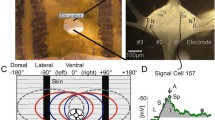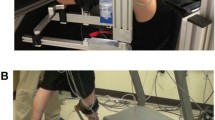Abstract
The leech whole-body shortening reflex consists of a rapid contraction of the body elicited by a mechanical stimulus to the anterior of the animal. We used a variety of reduced preparations — semi-intact, body wall, and isolated nerve cord — to begin to elucidate the neural basis of this reflex in the medicinal leech Hirudo medicinalis. The motor pattern of the reflex involved an activation of excitatory motor neurons innervating dorsal and ventral longitudinal muscles (dorsal excitors and ventral excitors respectively), as well as the L cell, a motor neuron innervating both dorsal and ventral longitudinal muscles. The sensory input for the reflex was provided primarily by the T (touch) and P (pressure) types of identified mechanosensory neuron. The S cell network, a set of electrically-coupled interneurons which makes up a ‘fast conducting pathway’ in the leech nerve cord, was active during shortening and accounted for the shortest-latency excitation of the L cells. Other, parallel, interneuronal pathways contributed to shortening as well. The whole-body shortening reflex was shown to be distinct from the previously described local shortening behavior of the leech in its sensory threshold, motor pattern, and (at least partially) in its interneuronal basis.
Similar content being viewed by others
Abbreviations
- conn :
-
connective
- DE :
-
dorsal excitor motor neuron
- DI :
-
dorsal inhibitor motor neuron
- DP :
-
dorsal posterior nerve
- DP:B1 :
-
dorsal posterior nerve branch 1
- DP:B2 :
-
dorsal posterior nerve branch 2
- MG :
-
midbody ganglion
- VE :
-
ventral excitor motor neuron
- VI :
-
ventral inhibitor motor neuron
References
Bagnoli P, Brunelli M, Magni F (1972) A fast conducting pathway in the central nervous system of the leech Hirudo medicinalis. Arch Ital Biol 110: 35–51
Bagnoli P, Brunelli M, Magni F (1975) The neuron of the fast conducting system in Hirudo medicinalis: identification and synaptic connections with primary afferent neurons. Arch Ital Biol 113: 21–43
Blackshaw SE, Nicholls JG, Parnas I (1982) Physiological responses, receptive fields and terminal arborizations of nociceptive cells in the leech. J Physiol (Lond) 326: 251–260
Boulis NM, Sahley CL (1988) A behavioral analysis of habituation and sensitization of shortening in the semi-intact leech. J Neurosci 8: 4621–4627
Bullock TH, Horridge GA (1965) Structure and function in the nervous systems of invertebrates. Freeman, San Francisco
Carbonetto S, Muller KJ (1977) A regenerating neurone in the leech can form an electrical synapse on its severed axon segment. Nature 267: 450–452
Drewes CD (1984) Escape reflexes in earthworms and other annelids. In: Eaton RC (ed) Neural mechanisms of startle behavior. Plenum, New York, pp 43–91
Eaton RC, DiDomenico R, Nissanov J (1991) Role of the Mauthner cell in sensorimotor integration by the brain stem escape network. Brain Behav Evol 37: 272–285
Frank E, Jansen JKS, Rinvik E (1975) A multisomatic axon in the central nervous system of the leech. J Comp Neurol 159: 1–13
Friesen WO (1989) Neuronal control of leech swimming movements. In: Jacklet JW (ed) Neuronal and Cellular Oscillators. Dekker, New York, pp 269–316
Gardner-Medwin AR, Jansen JKS, Taxt T (1973) The ‘giant axon’ of the leech. Acta Physiol Scand 87: 30A-31A
Granzow B, Friesen WO, Kristan WB Jr (1985) Physiological and morphological analysis of synaptic transmission between leech motor neurons. J Neurosci 5: 2035–2050
Gu X (1991) Effect of conduction block at axon bifurcations on synaptic transmission to different postsynaptic neurones in the leech. J Physiol (Lond) 441: 755–778
Kramer AP (1981) The nervous system of the glossiphoniid leech Haementeria ghiliani. II. Synaptic pathways controlling body wall shortening. J Comp Physiol 144: 449–458
Krasne FB, Wine JJ (1984) The production of crayfish tailflip escape responses. In: Eaton RC (ed) Neural mechanisms of startle behavior. Plenum, New York, pp 179–211
Kretz JR, Stent GS, Kristan WB Jr (1976) Photosensory input pathways in the medicinal leech. J Comp Physiol 106: 1–37
Kristan WB Jr (1982) Sensory and motor neurones responsible for the local bending response in leeches. J Exp Biol 96: 161–180
Kristan WB Jr, Stent GS, Ort CA (1974) Neuronal control of swimming in the medicinal leech I. Dynamics of the swimming rhythm. J Comp Physiol 94: 97–119
Kristan WB Jr, McGirr SJ, Simpson GV (1982) Behavioural and mechanosensory neurone responses to skin stimulation in leeches. J Exp Biol 96: 143–160
Laverack MS (1969) Mechanoreceptors, photoreceptors, and rapid conduction pathways in the leech, Hirudo medicinalis. J Exp Biol 50: 129–140
Lockery SR, Kristan WB Jr (1990 a) Distributed processing of sensory information in the leech I. Input-output relations of the local bending reflex. J Neurosci 10: 1811–1815
Lockery SR, Kristan WB Jr (1990 b) Distributed processing of sensory information in the leech II. Identification of interneurons contributing to the local bending reflex. J Neurosci 10: 1816–1829
Magni F, Pellegrino M (1978 a) Patterns of activity and the effects of activation of the fast conducting system on the behavior of unrestrained leeches. J Exp Biol 76: 123–135
Magni F, Pellegrino M (1978 b) Neural mechanisms underlying the segmental and generalized cord shortening reflexes in the leech. J Comp Physiol 124: 339–351
Mason A, Kristan WB Jr (1982) Neuronal excitation, inhibition and modulation of leech longitudinal muscle. J Comp Physiol 146: 527–53
Mistick DC (1978) Neurons in the leech that facilitate an avoidance behavior following nearfield water disturbances. J Exp Biol 75: 1–24
Muller KJ, Carbonetto S (1979) The morphological and physiological properties of a regenerating synapse in the C. N. S. of the leech. J Comp Neurol 185: 485–516
Muller KJ, Scott SA (1981) Transmission at a ‘direct’ electrical connexion mediated by an interneurone in the leech. J Physiol (Lond) 311: 565–583
Muller KJ, Nicholls JG, Stent GS (1981) Neurobiology of the leech. Cold Spring Harbor Laboratory, Cold Spring Harbor, New York
Nicholls JG, Baylor DA (1968) Specific modalities and receptive fields of sensory neurons in the C. N. S. of the leech. J Neurophysiol 31: 740–756
Ort CA, Kristan WB Jr, Stent GS (1974) Neuronal control of swimming in the leech II. Identification and connections of the motor neurons. J Comp Physiol 94: 121–154
Otis TS, Gilly WF (1990) Jet-propelled escape in the squid Loligo opalescens: Concerted control by giant and non-giant motor axon pathways. Proc Natl Acad Sci USA 87: 2911–2915
Peterson EL (1984) The fast conducting system of the leech: A network of 93 dye-coupled interneurons. J Comp Physiol A 154: 781–788
Phillips CE, Friesen WO (1982) Ultrastructure of the water-movement-sensitive sensilla in the medicinal leech. J Neurobiol 13: 473–486
Sahley CL, Modney BK, Boulis NM, Muller KJ (1994) The S cell: An interneuron essential for sensitization and full dishabituation of leech shortening. J Neurosci 14: 6715–6721
Shaw BK, Kristan WB Jr (1994) The whole-body shortening reflex of the leech: Motor pattern, sensory basis, and interneuronal pathways. Soc Neurosci Abstr 20: 1598.
Stierle IE, Getman M, Comer CM (1994) Multisensory control of escape in the cockroach Periplaneta americana. I. Initial evidence from patterns of wind-evoked behavior. J Comp Physiol A 174: 1–11
Stuart AE (1970) Physiological and morphological properties of motoneurones in the central nervous system of the leech. J Physiol (Lond) 209: 627–646
Weeks JC (1982) Segmental specialization of a leech swim-initiating interneuron, cell 205. J Neurosci 2: 972–985
Wilkinson JM, Coggeshall RE (1975) Axonal numbers and sizes in the connectives and peripheral nerves of the leech. J Comp Neurol 162: 387–396
Wittenberg G, Kristan WB Jr (1992 a) Analysis and modeling of the multisegmental coordination of shortening behavior in the medicinal leech I. Motor output pattern. J Neurophysiol 68: 1683–1692
Wittenberg G, Kristan WB Jr (1992 b) Analysis and modeling of the multisegmental coordination of shortening behavior in the medicinal leech II. Role of identified interneurons. J Neurophysiol 68: 1693–1707
Yau KW (1976) Receptive fields, geometry and conduction block of sensory neurones in the C. N. S. of the leech. J Physiol (Lond) 263: 513–538
Author information
Authors and Affiliations
Rights and permissions
About this article
Cite this article
Shaw, B.K., Kristan, W.B. The whole-body shortening reflex of the medicinal leech: motor pattern, sensory basis, and interneuronal pathways. J Comp Physiol A 177, 667–681 (1995). https://doi.org/10.1007/BF00187626
Accepted:
Issue Date:
DOI: https://doi.org/10.1007/BF00187626




